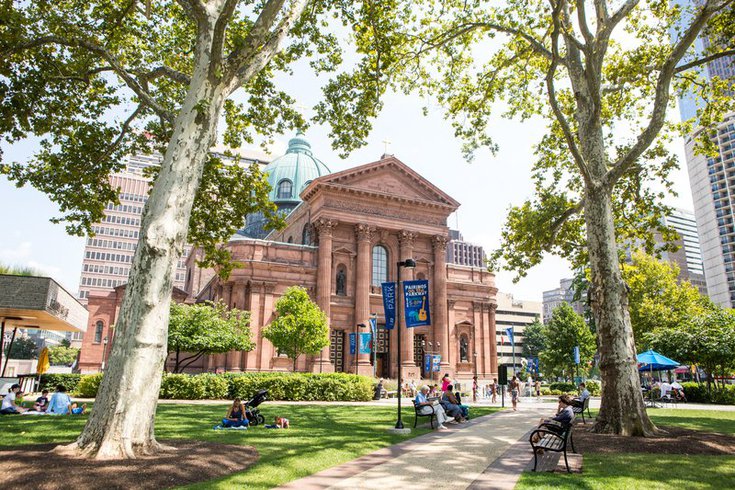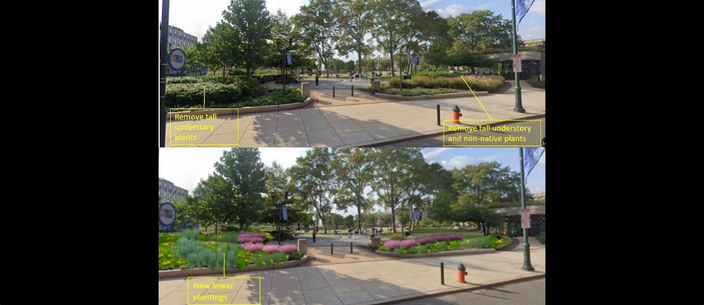
July 19, 2023
 Thom Carroll/PhillyVoice
Thom Carroll/PhillyVoice
A 4,000-plant pollinator garden is being installed in Sister Cities Park, which will offer an urban refuge for birds, bees and butterflies. Above, a file photo of Sister Cities Park.
Logan Square visitors will soon be charmed by colorful butterflies, buzzing bumblebees and melodic birds in a beautiful field of plants and flowers.
Center City District is renovating a 6,000-square-foot area of Sister Cities Park — a public space located on Benjamin Franklin Parkway midway between City Hall and the Philadelphia Museum of Art — into a pollinator garden featuring 4,000 native plants, flowers and grasses.
MORE: New FDR Park playground to open with largest swing set on the continent
This spring, sightline-blocking hedges were cleared to make room for the new garden, which will be located at the southeastern end of the park where North 18th Street and Ben Franklin Parkway meet.
New plantings were installed during the month of June in phases determined by weather and availability of the 14 plant varieties. The garden was planned by CCD's landscape team and horticulture partners to act as an urban refuge for birds, bees, butterflies and insects.
The Sister Cities Park area where the new pollinator garden is located is pictured before the sightline-blocking hedges were cleared (top). A rendering (bottom) shows what the garden will look like once the plants grow.
“The re-envisioning of this spot in Sister Cities Park is both beautiful and functional,” said CCD Vice President of Parks and Public Realm Prema Katari Gupta. “It will improve sightlines and visibility in the park, provide a joyous and colorful new experience for visitors, and create an eco-friendly benefit as what we believe will be Center City’s biggest pollinator garden.”
Pollinating plants in a small "test plot" planted two years ago are "thriving" today, giving visitors an indication of the lush, colorful flora they can expect to grow in the enlarged garden.
Some of the pollinator-friendly species include black-eyed Susan, common milkweed, bluestem, prairie dropseed, ironweed, Joe-Pye weed, goldenrod, blue flag iris and muhly grass. Each plant was selected for its ability to act as a source of food and shelter for migratory and native birds and insects.
🐝 NEW: 4,000 native flowering plants and grasses are being installed to create an urban haven for birds and insects in Center City's newest pollinator garden in Sister Cities Park! https://t.co/phktAeKbXJ pic.twitter.com/mtjNY4ZXPP
— Center City District (@ccdphila) July 19, 2023
Animal pollinators — like bees, beetles, moths, butterflies, birds and bats — are crucial to humans' food supply because they pollinate the crops that we consume. Unfortunately, habitat loss and environmental contaminants are contributing to a decline in the number of pollinators; many die because they cannot find the right quantity or quality of food, which comes from the nectar and pollen of blooming plants. There aren’t enough pollinator-friendly plantings to support pollinators in the United States, which is why pollinator gardens like the one at Sister Cities Park are important.
Sister Cities Park was first dedicated in 1976 to recognize Philadelphia's commitment to the international Sister Cities partnership program. The park was redesigned and rededicated in 2012.
Along with its new pollinator garden, Sister Cities Park also houses a café, the Children's Discovery Garden and a fountain with 11 geyser-like spouts, to represent each of Philadelphia's sister cities.
Sister Cities Park is open every day from 6-1 a.m.
Follow Franki & PhillyVoice on Twitter: @wordsbyfranki
| @thePhillyVoice
Like us on Facebook: PhillyVoice
Have a news tip? Let us know.
 Provided Image/Center City District
Provided Image/Center City District